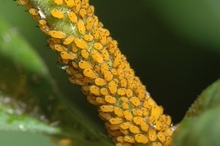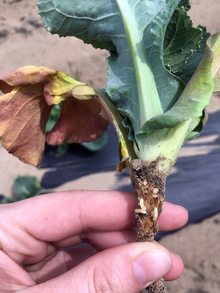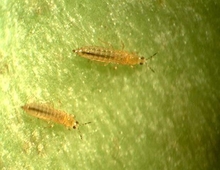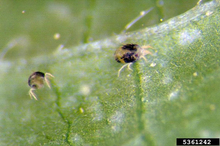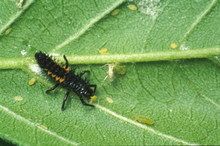While Minnesota barrels through its first heatwave of 2021, many are counting on their hoses, sprinklers and watering cans to keep their lawns and gardens green. This stretch of hot, dry weather pushed plants along, but what about plant pests?
Each species of insect has an ideal range of temperatures for them to complete their life cycles. All insects are essentially cold-blooded, meaning they don’t make their own heat, instead they rely on the environment to warm their bodies and allow them to function.
Some insects like it cool
For example, cabbage maggot is an early-season pest of cabbage, broccoli, radishes and other brassica crops. This pest prefers cool temperatures (40°F to 60°F). This cold tolerance allows this pest to emerge early and lay eggs on young brassicas. The downside for the pest is that when weather conditions turn warm, cabbage maggot struggles. In fact, cabbage maggot eggs can die if the top few inches of the soil reach 95°F.
Some other insect pests that don’t like the heat include onion maggot, seedcorn maggot and cutworms (which struggle when the soil is dry).
Heat-loving bugs
Some insects thrive in hot weather, with the heat allowing them to produce more offspring in less time. Two insects and one insect relative you might notice (or, more likely, notice the damage they cause) are thrips, aphids and spider mites. While the creatures themselves are small, they are all able to quickly build their populations in this building heat.
Aphids
In Minnesota, we have a wide variety of aphid species, which feed on vegetables, garden plants, shrubs and trees. One thing aphid species have in common is a love of heat and an ability that is rare in the insect world: they give live birth. They also produce offspring without mating -- a process rare among all animals. For most of the summer, female aphids give live birth to genetic clones of themselves. This allows them to grow their populations very quickly, which can become a problem for the plants they are feeding on.
Aphids damage plants in a few ways.
- They cause direct damage to plants as they use their straw-like mouthparts to suck juices from the plant. This can weaken the plant and cause leaves to distort.
- When the sap comes out the other end it can spell even more damage for plants. Aphids secrete a sticky substance called honeydew, which can get on the plant’s leaves and fruit, and then grow mold. This can be hard to remove from things like pumpkins.
- Finally, aphids can transmit diseases when they feed on a virus-infected plant then move on to feed on an uninfected plant.
Thrips
Thrips are not as well known as aphids, as they are smaller and quicker-moving. Thrips feed similarly to aphids, as they puncture cells and feed on plant juices. Their mouthparts are a bit rougher on the leaf, resulting in feeding leaving behind small, discolored flecks or silver patches on leaves.
During periods of hot weather, they move onto whatever is juicy and well-watered in the landscape, meaning they can land in our gardens.
Like aphids, they reproduce quickly (though do not give live, virgin birth).
Spider mites
The final creature in our heat-loving triad is the two-spotted spider mite. Mites are more closely related to spiders than insects, having eight legs and sometimes spinning silk netting around the areas where they are feeding. Spider mites generally feed on the underside of leaves, puncturing cells and feeding. This damage can appear as small brown or yellow areas on the leaf but, if feeding is severe, the whole leaf can become brown and crispy. Their ability to reproduce quickly under hot conditions (>90°F) means populations may be booming in some Minnesota gardens.
So, what to do?
The first instinct for all these pests might be to spray something, but this is almost never a good solution in the home garden. These small insects are primarily controlled by other insects, and many pesticides aren’t selective in what bugs they kill. There are many thrips, aphids, and mites in the greater landscape, and as soon as you spray, it is very possible that more will come into your garden. Once there, they can reproduce unchecked by predatory insects, which are overall fewer in number and slower to reproduce.
There is one spray that can work well against these small insects — your water hose. Both aphids and thrips can be knocked from leaves with water and killed in the process.
The overall best strategy for dealing with these pests is to increase the number of beneficial insects in your landscape.
Beneficial insect predators include ladybugs, minute pirate bugs, syrphid fly larvae, lacewing larvae, and parasitoid wasps. People often want to order these bugs from a garden catalog, but a more effective long-term strategy is to diversify the plants in your garden. Different bugs like different plants as a source of food and shelter. Any work you’ve done to benefit pollinators will serve you well, as predatory insects like many of the same things.
Another option is to wait out the heat. Once this heatwave breaks, these insects’ populations typically dip back down to non-noticeable levels.
Bessin, R., Foster, R., and Flood, B. (2005). Vegetable insect management. Meister Pub. Co.
Hazzard, R. (2020, October 2). Cabbage Root Maggot. Center for Agriculture, Food and the Environment.


